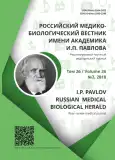Построение компьютерной модели при морфометрии тканей
- Авторы: Васин А.С.1, Давыдов В.В.1, Свирина Ж.А.1
-
Учреждения:
- ФГБОУ ВО Рязанский государственный медицинский университет им. акад. И.П. Павлова Минздрава России
- Выпуск: Том 26, № 3 (2018)
- Страницы: 345-350
- Раздел: Оригинальные исследования
- URL: https://journals.rcsi.science/pavlovj/article/view/10281
- DOI: https://doi.org/10.23888/PAVLOVJ2018263345-350
- ID: 10281
Цитировать
Аннотация
При исследовании тканей животных и человека под микроскопом исследователи сталкиваются с проблемой их объективной оценки. Описательная микроскопия является субъективной и не позволяет сделать точных выводов. Частичный подсчет выборочных элементов ткани часто недостаточно информативен. Использование полноценной морфометрии является крайне трудоемкой процедурой, которую сложно провести, повторить и перепроверить. Применение описательной микроскопии не позволяет построить модель исследования для всесторонней оценки полученных результатов, что затрудняет выводы.
Цель. Решить проблему объективной оценки состояния тканей при гистоморфологических исследованиях и ускорить их выполнение с помощью компьютерного моделирования.
Материалы и методы. Весь процесс от получения микропрепарата исследуемой ткани до окончания его полноценного анализа был разделен на 4 этапа: 1) фотографирование всей площади микропрепаратов с помощью видеоокуляра микроскопа, 2) подсчет гистоморфологических элементов на фотографиях, 3) построение компьютерной модели, 4) анализ полученных данных.
Результаты. Нами была построена интерактивная компьютерная модель эксперимента, в которой все параметры были связаны в единую совокупность, и изменение любого значения влияло на всю модель. В ней можно визуализировать полученные результаты, рассчитывать новые параметры, находить взаимосвязи между ними и использовать дополнительные инструменты, например, использовать машинное обучение для поиска неочевидных взаимосвязей между компонентами или ускорения дальнейших расчетов.
Выводы. Достоинствами компьютерного моделирования является то, что оно существенно ускоряет проведение гистоморфологических исследований, улучшает качество их обработки, делает их более объективными и дает ученым больше возможностей для глубокого анализа. Важным преимуществом компьютерного моделирования является то, что оно может использоваться для любых гистоморфологических исследований.
Полный текст
Открыть статью на сайте журналаОб авторах
Антон Сергеевич Васин
ФГБОУ ВО Рязанский государственный медицинский университет им. акад. И.П. Павлова Минздрава России
Автор, ответственный за переписку.
Email: anto-vasin@inbox.ru
ORCID iD: 0000-0003-3790-4620
SPIN-код: 2387-3689
ResearcherId: A-7261-2018
аспирант кафедры патофизиологии
Россия, 390026 г. Рязань, ул. Высоковольтная, д. 9Виктор Викторович Давыдов
ФГБОУ ВО Рязанский государственный медицинский университет им. акад. И.П. Павлова Минздрава России
Email: anto-vasin@inbox.ru
ORCID iD: 0000-0001-6479-7504
SPIN-код: 1356-7511
ResearcherId: S-3209-2016
д.м.н., профессор кафедры патофизиологии
Россия, 390026 г. Рязань, ул. Высоковольтная, д. 9Жанна Александровна Свирина
ФГБОУ ВО Рязанский государственный медицинский университет им. акад. И.П. Павлова Минздрава России
Email: anto-vasin@inbox.ru
ORCID iD: 0000-0001-5895-231X
ResearcherId: D-2931-2018
к.м.н., ассистент кафедры патофизиологии
Россия, 390026 г. Рязань, ул. Высоковольтная, д. 9Список литературы
- Автандилов Г.Г. Медицинская морфометрия. Руководство. М.: Медицина; 1990.
- Мустафин Ч.Н., Кузнецова С.В. Дисгормональные болезни молочной железы. Клиническое руководство. М.: Медицина; 2009.
- Чумаченко П.А., Шлыков И.П. Молочная железа: морфометрический анализ. Воронеж: Издательство Воро-нежского государственного университета; 1991.
- Васин А.С., Давыдов В.В., Свирина Ж.А. Исследование влияния релиз-активных препаратов на фиброзно-кистозную мастопатию // Фундаментальные аспекты психического здоровья. 2017. №2. С. 156-159.
- Мнихович М.В. Эпителиальный и стромальный компоненты при протоковом раке молочной железы. Россий-ский медико-биологичес-кий вестник имени академика И.П. Павлова. 2015. Т. 23, №3. С. 99-105. doi:10.17816/ PAVLOVJ2015399-105
Дополнительные файлы








